17 November, 2003
Move 'Em Out Little Doggies!
Temperature: 10*F
Location: Lake Fryxell, Dry Valleys
I awoke this morning to the sound of the glacier groaning. It
sounded as if someone was knocking on the inside trying to get out.
Imagine taking a fifty five gallon drum and squeezing in the sides.
Take this squeezed drum into a long wooden tunnel and then release
the sides and let the drum "pop" back to its original girth. Then,
listen to the sounds reverberate through the tunnel. These are the
noises the glacier made this morning!
I enjoyed the sounds of the glacier for a bit and then gathered all
my things and took them to the helicopter pad. The helicopter came
and flew us over the Canada Glacier and dropped us off at Lake
Fryxell. We had two sling loads, which are large loads carried on a
sling, attached by a cable below the helicopter, followed behind us.
We spent a few moments getting settled into our new home and then got
to work.
Our first task was to melt out a monitoring station that has become
frozen in the lake. This parcticular station has eight temperature
probes, each positioned at a different depth of the lake. Each year
the cables freeze into the ice. Over time, as the lake ice ablates,
the cables get drawn up closer to the surface. This alters their
positions, so they must be reset. This involves melting the cables
out of the ice and relowering them to their proper positions. Easy
enough, until you're dealing with over five meters of ice!
We first set up a "jiffy drill" with a ten inch auger. WE drilled
through the ice until we reached the top of the auger. We added
another yard long section called a "flight." After five flights, we
still had not hit water, but Peter knew we were getting close. We
attached the "trombone," a similar set up to the hot finger discussed
earlier, but smaller. The trombone melted through the ice in no
time! We then set up the "hot finger" to start the serious melting
operation.
On to hole number two. All was going well, until I dropped the set
of allen wrenches down the hole! Production came to an immediate
stop! The wrench was three auger wraps down - just out of reach and
precariously perched to slide almost four meters down the hole.
We started chipping from the side of the hole with the intention of
digging a "tunnel" to the level of the wrench and then grab it. It
was almost in reach when the drill was bumped and the wrench slid
about two feet further down the hole. We were in a jam - it was "do
or die." Phil, Roman, and I gave a swift upward pull to the drill
and Peter reached in and grabbed the wrench. Phew! I now make sure
a catch pad is installed at the top of the hole! We finished
drilling this hole, which would be used to melt out some equipment
being removed from the lake.
On to hole number three. This one would be used to determine the
"lake level"; this is the level water would be at if there was no ice
in the lake. We set up surveying equipment to determine the level of
the lake.
We set up the surveying scope to view the bench mark which is set up
by the hut. Peter recorded the measurement, and Phil swung the
survey scope to get the next reading from the ice. This years lake
level was determined.
Lake level is one of the more important measurements made here. The
level not only provides information about local climate fluctuations,
but also is an indicator of the water available in the area. Cold
summers, which have low lake levels, expose more soil to the air.
Warm summers, which have high lake levels, flood more soil areas.
The moisture/drying fluctuations have a significant impact on the
microbial life in the area. The glaciers, lakes, summer streams, and
soils all interact to provide an ecosystem at the edge of its ability
to sustain life.
All is well and I'm having the time of my life!
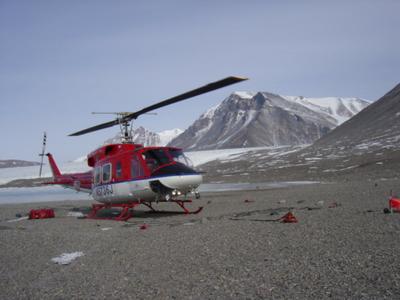
1. The helicopter that transported us to Lake Fryxell.
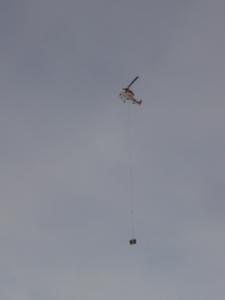
2. Bringing in one of our sling loads.
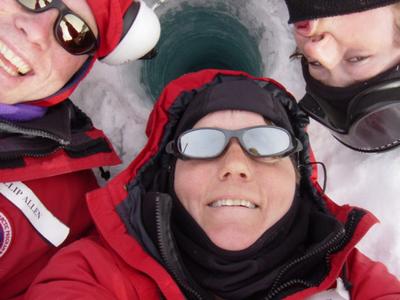
3. Proud hole drillers!
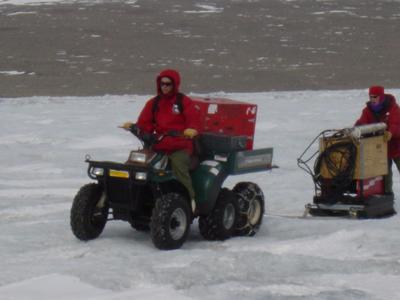
4. Peter and Phil bringing over the generator and hotsy to set up the "hot finger."
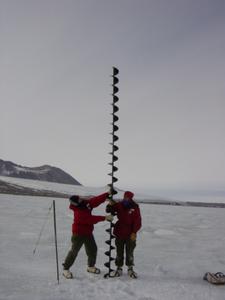
5. The jiffy drill augers with five "flights" - we're still not through the ice... it's thick!

6. Phil surveying the lake level.
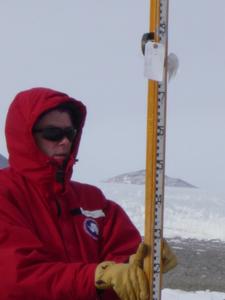
7. Peter holding the surveying staff.
Contact the TEA in the field at
.
If you cannot connect through your browser, copy the
TEA's e-mail address in the "To:" line of
your favorite e-mail package.
|
